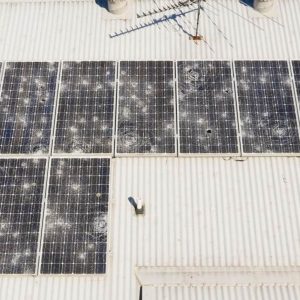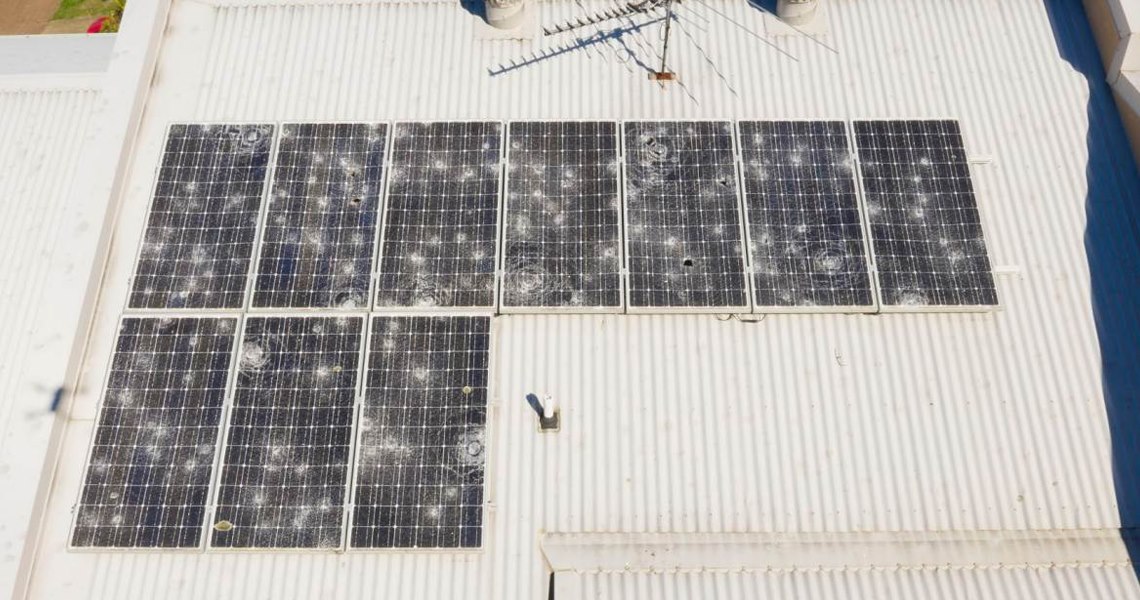Solar panels are designed to be tough in order to withstand extreme weather elements including hail and storms.
But when debris the size of golf balls suddenly rattle down, the havoc caused is often costly and beyond repair as witnessed on Saturday in southeast Queensland when freak hailstorms pounded the area.
Testing solar panels for hail damage is mandatory under the Australian Standards and for a solar panel to pass the Moderate Hail Test, it must survive the force exerted by a 25mm ice ball fired at speeds of 23m/s on 11 different spots on the module.
To pass the Severe Hail Damage Resistance Test, a solar module must withstand a 75mm diameter hailstone exposed to similar testing conditions.
As a matter of fact, most manufacturers test their solar panels to ensure they are not susceptible to damage by hailstones and thunderstorms.
However, just like how car windscreens get damaged by mammoth hailstones, sometimes the same happens to solar panels.
According to a study commissioned by the Energy Department and carried out by the National Renewable Energy Laboratory (NREL), a sample survey of 50,000 solar photovoltaic systems installed in the United States between 2009 and 2013 showed that only 0.1% of the panels got damaged or became malfunction after a catastrophic Mother Nature event.
Huge Hailstones
A 25mm hailstone is quite big and the 75mm one considered huge. But the hailstones that rained in various parts on Saturday were simply gigantic. Reports show that hail witnessed in Forestdale in Brisbane’s south measured up to 14cm.
The images and videos shared on social media by residents in the area are enough proof of solar panel carnages that occurred in various places:
This video provides a perfect display of the storm’s ferocity and how hail cut through a rooftop and into the insulation and ceiling.
The solar panels on the home’s roof couldn’t withstand this kind of nature’s onslaught and that’s no surprise at all, but it was more distressful for households that suffered hail damage.
Of course, roof tiles, solar panels, vehicles etc. can always be replaced but not lives—and the bit of good news is that there were no serious injuries or deaths reported.
Storm Damage – Safety of Solar Power System
Solar systems can still generate energy from panels up to the inverter even when the panels are damaged or power from the main grid gets disconnected following a severe storm activity.
Australiansolarquotes recommends that you:
Strictly follow the shutdown procedures provided if your home’s roof or system gets damaged or you doubt the integrity of the solar system.
Do not reconnect your solar PV system on your own or inspect your roof after a severe storm event or when your roof seems damaged.
Always contact a CEC certified installer to help recommission the PV system for you. Alternatively, you can contact a licensed electrical contractor to inspect the system and make sure it’s safe.
We further advice that during a flood event, don’t turn off your solar system when any of the components are submerged in water or the parts are wet—and stay away.
Hail, Solar Panels And Insurance
Solar panels are a valuable addition to your property and hence they should be covered under the home and contents insurance policy which hopefully also covers extreme weather events like hail storms.
It’s also prudent for solar power system owners to ask their insurers to increase the sum insured of the building.
On November 1, the Insurance Council of Australia (ICA) declared a catastrophe any damage caused by the hailstorm event. The ICA reports that by Sunday 2pm, insurance companies had received over 5,000 claims, with the total insured losses approximated at $60 million as at then.
“About 60 per cent of claims are for damage to motor vehicles, and 40 per cent for damage to houses – mainly to roofs, skylights and solar panels, and interior damage to a significant proportion of homes,” stated ICA.
The Council added that insurers were anticipating an influx of fresh claims for the next couple of days. It warned of infiltration by “disaster chasers” who were already hovering around. “They may offer cash repairs, or ask you to sign a contract and claim your insurer will pay for everything. Speak to your insurer before you authorise any work.”

